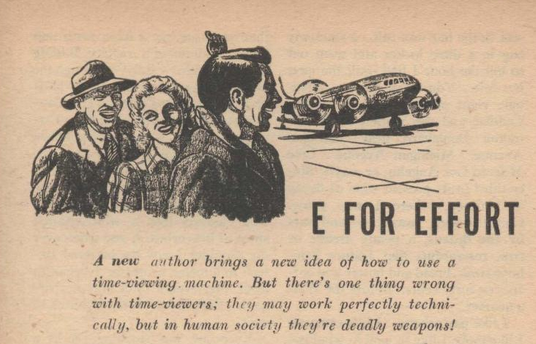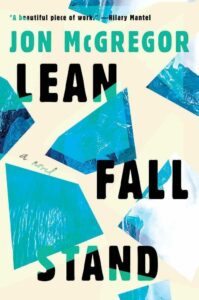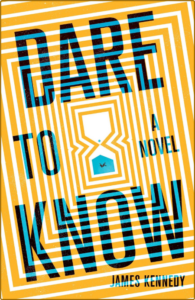Science fiction readers recognize the old distinction between stories that are rigorous about scientific plausibility (“hard” SF) and stories that are more fantastical or philosophical (“soft” SF). And writers know wherever there’s a binary, there’s artistic opportunity in breaking it. I appreciate stories that scramble the mechanical and the mystical.
By treating fantastical machines, algorithms, and social processes with what feels like hard-SF rigor, we can approach ideas in a fresh way. In Isaac Asimov’s Foundation series, “psychohistorians” use mathematics to predict the futures of entire societies (a riff, perhaps, on Marxist dialectical materialism). In Cixin Liu’s Three Body Problem trilogy, aliens flood Earth with invisible surveillance particles called “sophons”—a nod to our own eroded privacy.
A border is crossed when abstractions like these—predestination and omniscience—become achievable engineering goals. We feel a shiver.
My own speculative thriller, Dare To Know, is about a company that can tell you, with perfect accuracy, the precise time of your death. Here are some of my favorite stories of other technologies that blur the line between physics and philosophy.

E For Effort, by T.L. Sherred
In T.L. Sherred’s novelette E For Effort (1947), a wry hustler links up with the blue-collar inventor of a device that can film the past: anytime, anyplace. To make a buck, they use it to produce astonishing historical movies of the real Alexander the Great or the actual Fall of Rome (amusingly, sometimes having to “correct” this footage to fit our historical misconceptions). Box office is huge. Hollywood is baffled: how’d two nobodies craft such amazingly realistic movies, with apparent casts of thousands? Trouble brews when their movies portray more politically-charged history, such as the Civil War. Our heroes, disillusioned by the appalling secrets they’ve witnessed via their invention, reveal their miracle device to the world—along with a final movie that exposes the hypocrisy, brutality, and profiteering on both sides of recently-concluded World War II. Social chaos erupts. “The machine can make treachery and untruth impossible,” predicts our wiseguy-turned-idealist. Nope. It doesn’t end well for him, or anyone.
I found this in a science-fiction anthology when I was 13. It was the first sci-fi I’d read in which the heroes felt genuinely working-class. The inventor wasn’t a white man in a lab coat, but a frustrated Mexican-American Detroiter, cobbling his machine together with military surplus radio and radar equipment. It captures the giddy thrill of being part of a successful startup, but grounds each step in the material realities of immediate postwar America. Both down-to-earth and mindblowing, this story makes much other 1940s sci-fi feel quaint.

The Tumor With A Human Face by Tanizaki Junichiro
Tanizaki Junichiro’s The Tumor With A Human Face (1918) is a short story about the then-novel technology of film and its uncanny effect on the first generation who experienced it. A Japanese actress hears rumors about a grotesque cult film that she apparently stars in. The problem: she doesn’t remember making that movie. Onscreen, she sprouts a tumor with a human face that that drives her character to a tragic end. Worse, the hard-to-obtain movie is said to be cursed: anyone who watches it alone at night goes mad or dies. How was this movie made? Spliced together using existing footage plus double exposure? Or is something more eerie at work?
This might be the first “haunted movie” story. It delves into interesting detail about making and distributing a film in 1918, which adds verisimilitude in pursuit of its deeper aim: expressing the queasy psychology of this new art form. In the darkness of the theater, there is terror in overidentifying with the image, and forfeiting one’s reality to it—in becoming one’s own uncanny Other. The story’s matter-of-fact tone might cause one to miss its unsettling final line: “They’ll surely make many copies and distribute widely this time. That’s exactly what they’ll do.” Nightmare at industrial scale.

Magic for Beginners, by Kelly Link
Kelly Link’s 2005 short story Magic for Beginners (from her collection of the same name) is too tricky to sum up easily, but for me it feels like a modern successor to Tanizaki’s story. Nowadays the reality-blurring technology of motion pictures has been domesticated; here, uncanniness springs from reality-blurring social technology of fandom.
The story is about an ordinary TV show called The Library, which is about a group of twee Vermont kids obsessed with a whimsical show-within-a-show also called The Library (think Buffy by way of Francesca Lia Block), which appears at random times and on random channels. Link’s story is written is such a way as to encourage confusion between the layered metafictions. It effectively captures the fevered flush of teenage enthusiasm for a shared TV show—watching and re-watching it with friends, debating its finer points, dressing up as its characters, letting it seep into your life—sometimes so intensely that you feel that your life is also somehow seeping into it?
I wish I could watch The Library, the details of which are only hinted at (a hero fights then befriends a monstrous George Washington statue; a woman gives birth to snakes that help her find a magical book; mysterious commercials advertise impossible products). The story is affectionate, nostalgic, and creepy all at once—its slippery realities precisely charting a fannish delirium. Think “Videodrome for sensitive teens” and you’re halfway there.

The Intuitionist by Colson Whitehead
When I try to explain it, the technological premise of Colson Whitehead’s The Intuitionist (1999) almost sounds silly. In a 1940-ish New York, elevator inspectors comprise an elite class of civil servants bitterly divided into two philosophical camps: the Empiricists who judge an elevator’s worthiness by examining its tangible mechanisms, and the Intuitionists who can directly feel whether an elevator is up to code. At first you think Colson Whitehead must’ve lost a bet. And then you realize he’s a genius. He makes us believe in his far-out premise by grounding it in gritty workaday detail: the municipal bureaucracy, the petty office politics, the racial slights. Our hero is the first Black female elevator inspector and an Intuitionist, making her doubly suspect among the white old-boy’s club of Empiricists. Admirably prickly, resourceful, and nobody’s fool, when she’s framed for an elevator crash, she’s pulled into noir-ish intrigues that put her on the scent of the Black Box, a philosophically “perfect elevator” that just might raise the entire city into a new, better reality.
What can I say? Colson Whitehead can’t write a bad book. Although he went on to bigger things later, this remains my favorite of his. He exploits the strange premise to make fresh and cogent points about racism, sexism, and politics in America.

The Red Tower by Thomas Ligotti
The other day I received a strange knickknack from Amazon that I never ordered, and it reminded me of Thomas Ligotti’s short story The Red Tower (1996), the Necronomicon of online delivery. The Red Tower is a desolate three-story factory and distribution center, inaccessible but connected to all points in the country by underground tunnels, and the source of a constant torrent of grotesque novelty items such as “a peculiar ashen lump that betrayed some semblance of a face” or “a bulbous gourd designed to produce a long, deafening scream whenever picked up”—all delivered unasked-for into closets, or onto bedside tables, or even straight inside living bodies. The feverish production and instant delivery of these unwanted products, the Red Tower’s eventual development into breeding uncanny “hyperorganisms,” and its blighting of the world around it, can all be read as a fable of berserk capitalism (when the factory’s machinery suddenly evaporates, and yet its activities only intensify, it feels like an allegory of postindustrialism), but the story elicits unease deeper than the economic. Lovecraft by way of the Rust Belt, I doubt there’d be a “Welcome To Night Vale” without Ligotti.

The Infernal Desire Machines of Doctor Hoffman by Angela Carter
Angela Carter’s The Infernal Desire Machines of Doctor Hoffman (1972) isn’t for the squeamish. A city is under attack by Doctor Hoffman’s orgasm-powered machines that twist reality itself, flooding the city with obscene and shocking illusions. Most people lose their minds in response; civil order has collapsed and crime is rampant. The Ministry of Determination is on the case, sending our fantasy-immune hero on a picaresque journey through realms of unsettling hallucination and hard-to-stomach sexual horror to assassinate the villainous doctor and re-assert reality.
If you’ve had it with timid books, this is for you. It portrays a world that feels as if the most revolting/bewitching gutters of the internet have taken physical form to run rampant. Funny, disgusting, and truly shocking, I occasionally had to set it aside to take a breather. But often it was only minutes later that I came sniffing back. I love it when an author seems to mutter “fuck it” and swings for the fences, not caring whom she alienates along the way. We can all learn from Angela Carter.

Piranesi by Susannah Clarke
When recommending Susannah Clarke’s excellent Piranesi to a friend, I described it as “like watching someone play Zork for two hundred pages, but in a good way.” That got me to thinking that, as a teenager, much of my literary experience came not only from books but also “interactive fiction”—text-only 1980s video games in which you control your character by typing full sentences like “kill the troll with the sword” that the computer would understand and respond to, in prose that was surprisingly well-written and witty. The best of these games was Brian Moriarty’s Trinity (1986), in which the technology of nuclear weapons is metaphysically tweaked.
You’re on the last day of your London vacation when a Soviet nuclear missile appears in the sky, threatening to obliterate the city. You escape through a weird door floating in mid-air, and access a bizarre realm in which every man-made nuclear explosion is mystically connected. You travel between ground zero at Nagasaki, the atomic tests at Eniwetok Atoll, an SDI testing in space, a Siberian nuclear test, and other sites of atom-splitting violence, finally reaching the New Mexico Trinity test in 1945—and an opportunity to sabotage the Bomb, and all atomic bombs, by altering the very laws of physics. It’s unexpectedly literary and ambitious for a video game of its time—that is to say, it blew my adolescent mind. Replaying it thirty-odd years later, I found it still holds up.
And that’s the most we can hope for—especially in a genre that often predicts the future, either on purpose or inadvertently. (As for the death-prediction premise of my own book, this website assures me that I’ll die on December 19, 2046.)
***
Editor’s note: A previous version of this essay incorrectly attributed its authorship, and has since been corrected.



















